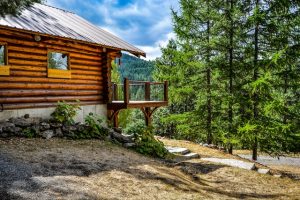Timber is one of the few natural, sustainable construction materials used in home extensions as well as for the main house build. The cyclical process involved in the harvest and regeneration of forests for timber production ensures that timber will last to be available. Every time a tree is harvested around ten trees are then re-established in its location; the renewable cycle starts again. Being a natural source, wood is not poisonous, and so is safe to handle and touch; it also ages naturally and does not break down into environmentally damaging material.
Carbon Favourable
Timber is a known as a Greenhouse Positive using a lower net environmental impact than most other building materials, like emission-intensive steel, aluminium, or concrete. It is one of the only building materials that bring about the long-term reduction of carbon emissions: favourably addressing climate change.
Carbon is an elemental building block of all living things in the world. As a forest grows, the trees absorb atmospheric carbon dioxide and store it in their leaves, branches, and trunks. Approximately half the dry weight of a living tree is carbon, kept for the life-span of the tree, and retained throughout the timber manufacturing process.
In 2015 Australia built 115,989 detached houses. If all of those homes were timber-framed, it might equal a total of 1,159,890 tonnes of carbon dioxide because the harvested plantations are replanted and start the cycle of carbon retention all over again.

Health Benefits
World studies have proven that being surrounded by timber in your home, work or school has positive effects our health. A recent report commissioned by Planet Ark has discovered that exposure to timber products and insides created similar health benefits to those made by spending time in nature. The report also including survey findings which revealed Australians are “innately drawn towards wood”.
Some of the reported health benefits include:
- Improved emotional state, also self-expression
- Increased air quality by moderating humidity, encouraging simpler breathing
- Feelings of warmth and relaxation
- Reduced blood pressure, heart rate, and anxiety levels
Australians spend over 90 percent of the time indoors; bringing nature indoors is a positive step to a healthy future, for you and the environment.
Natural Insulation
Timber is naturally an insulating material that creates a barrier between cold and heat.
The key is seen in the many air pockets inside the cellular structure of timber products, meaning that light-weight timber is a much better insulator as thermal conductivity increases with density. Building design with a focus on energy efficiency through lightweight timber can greatly contribute to maximising comfort and minimising non-renewable energy usage. Additionally, timber beams and timber framed buildings may allow for extra insulation materials to be put in areas between framing members without increasing ceiling, walls, roof or floor thickness. The natural thermal components of wood also maximise the efficiency of insulation materials as wood won’t become cold or exude warmth, therefore requiring less power to keep warmth during a building.
Wood is Great For Your Brain and Body
Obtain the ‘Housing, Health, Humanity’ report from Planet Ark to find a more in-depth comprehension of the health and health benefits of hardwood insides in homes, businesses, areas of learning and areas for healing. It also includes the results of an independent survey which explains the perspectives and opinions of Australians on wood.
A Few of the findings include:
- Residents in aged care facilities interact more with each other when surrounded by timber.
- Students in classrooms that feature more wood have lower heart rates and pressure responses than those in classrooms featuring plastic and metal.
- Two out of three employees prefer offices with wooden seats, desks and blinds over the same office with these items made from plastic.
Fire Performance
Yes, wood is a combustible material but it shines in a slow, predictable and measurable way. These variables mean that timber really performs strongly in flame events, when compared to other materials.
During the event of a fire, a charcoal layer will be formed on the surface of the wood and this coating will contribute to the fire resistance of the substance. The charcoal coating insulates the inner center of the timber and it will slow down the heat penetration, maintaining the temperate in the unburned material low and allowing the wood to carry its load considerably longer than steel. The protective charcoal layer created during a fire will also reduce the general combustion rate of the timber.
This natural self-defense mechanism raises the chance for a timber structure to survive a fire whilst preserving its strength and stability and is thus of great use in home extensions.
Low Energy Manufacturing
The practice of fabricating timber uses substantially less fossil fuel energy per unit volume than concrete, steel, or aluminium: minimising the quantity of pollutants created during the process. It follows that construction with a single cubic meter of wood, in place of other construction materials like concrete, blocks, or bricks, may save up 0.75 to 1 tonne of CO2 emissions.
To further minimise the environmental impact and increase your health and wellbeing consider options such as a solar power system or even changing the light bulbs to more energy efficient ones.

